Written by Joel T. Lewis 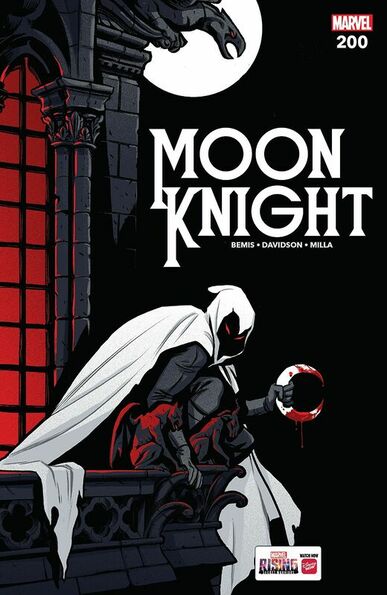 If you’ve read my rather heated review of Moon Knight #199 it will come as no surprise to you that I opened Max Bemis’ final chapter with understandable apprehension. The previous issue did not ‘ruin my childhood,’ fly in the face of the ‘spirit of the character,’ or anything so dramatic as those clichéd fanboy hardlines, it was simply a poorly written issue. So as I read the landmark 200th issue of Moon Knight I was admittedly guarded, but also hopeful. Was Bemis able to cap off his 13-issue run on Moon Knight with a winner? The answer is Yes and No. The most consistent problem with this final stretch has been with pacing and despite having 7 extra pages to play with in this issue, the book still manages to feel rushed. With more than a few microwaved subplots hurried along and sidelined in favor of the team-up between Moon Knight and Sun King (SK) which dominates much of the issue, #200 is oddly structured with much of the necessary stakes-making exposition taking place just moments before the final clash. Still, the issue is a fun ride if a convoluted and rushed one. After being defeated by Marc on Isla Ra, Sun King and the Truth are checked into a mental health facility and on their way to rehabilitation when Ernst arrives and breaks them out in order to enlist them in the Society des Sadique. Ernst is unsuccessful in converting SK who arrives after the society’s leader is killed by Moon Knight. In classic Marvel team-up fashion the two punch for a bit and then decide to become allies to combat the rising tide of society sadists left after the demise of Uncle Ernst. As Moon Knight, the Sun King, and the newly recruited Lunar Legion (from the end of issue #193) dispatch the remains of the Society of Sadists, Sun King eventually explains that Ernst’s master plan was to manipulate the Truth as a one-man weaponized propaganda machine to subjugate the masses under the society’s heal. The newly christened False Truth turns Ernst’s version of history on Marc’s mind and is rather anticlimactically defeated by Moon Knight’s vaguely defined, ‘Power of Crazy’ which Bemis has leaned on before. The society is defeated, the Truth is released, the Sun King returns to his mental health facility, and Marc walks shirtless through the rain to join his family for a long awaited rest. It’s a wordy comic with much of the expositional weight being carried by the returning SK, whose effusive philosophizing is just a little too close to the previous issue’s frustrating narration for comfort. The narrative framework is pretty sound: Moon Knight’s first and formative enemy recruits his latest and greatest in order to defeat him, but he miscalculates as the former foes work together to dismantle the larger scheme. But because Ernst died in the previous issue the threat which unites Moon Knight and his former enemy in this issue, the rest of the Society of Sadists, is an ill-defined, faceless, and utterly toothless foe. Also, with Ernst gone the super villain monologuing duties fall to Sun King who is an odd combination of moral center, narrator, and scheme summarizer in this issue. For a character we’ve only known as a villain to be absent from the comics for 6 issues and then return as a functionally redeemed antihero carrying all of the issue’s exposition is a lot of mental footwork for the audience to process and it ultimately unbalances the issue. 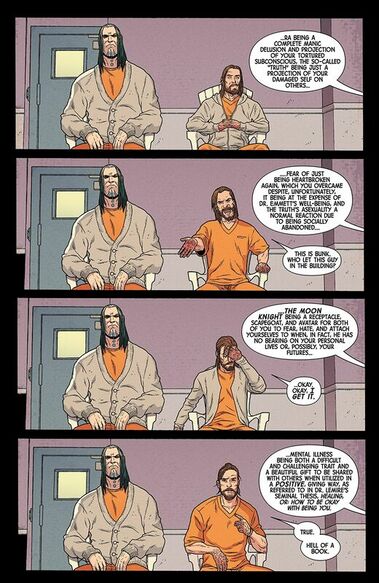 I did quite enjoy the Sun King/Moonie team-up quite a bit, despite how rushed their reconciliation felt, and the image of Marc on the back of SK’s motorcycle is about the most shippable image in Moon Knight comics to-date (and I most definitely ship Moon King). Though issue #198 was a much better showing for artist Jacen Burrows than the bizarre misfire of #197, Burrows’ mere 3-page flashback section at the beginning of this issue seems to make him a tourist in the book he defined the visual style for. This is truly a shame because Burrows was a big part of why I loved that first arc so much. That being said, I can’t really lament the return of Paul Davidson in this issue, especially when his 2 dual page spreads in this issue are so dynamic and chaotic, and his renditions of SK and Truth are so stunning. In this issue we also have writer and artist extraordinaire Jeff Lemire treating us to a page of Diatrice’s comic book depicting Old Man Spector, Marlene, and herself as a future space-suited Lunar Legionnaire which was outstanding. And closing out the artist section of this issue we must praise the return of Moon Knight hall of fame artist Bill Sienkiewicz whose final page illustration of a triumphant Marc Spector in the rain with Khonshu in the sky was utterly gorgeous. With the departure of Max Bemis as writer and no announcement of a new creative team or a renewal of the series in sight, this is perhaps the last we will see of Moon Knight for a while, and that’s perhaps what is most disappointing about this lackluster finale. I will be awaiting the return of the jet and silver avenger with baited breath, and I can assure you dear readers that when he returns, I will be hard at work reviewing his exploits for you once again! Until Next Time, Geek On!
0 Comments
Written by Zeke Perez Jr. 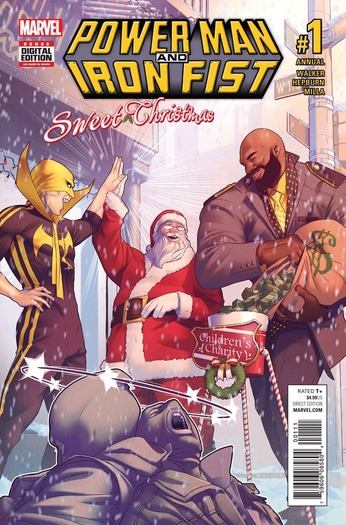 It’s the jolliest time of the year and our caped crusading companions are getting in the holiday spirit, too! Around this time of year, Marvel and DC release holiday specials and themed comics. To get in the festive spirit, I decided to read and review a few of them, new and old. For this go-around, I picked up three Marvel issues: a Marvel holiday special from this year, a Power Man and Iron Fist comic from 2016, and an Iron Man issue from 1990. If visions of holiday comics dance in your head and you want something to read while nestled snug in your bed, consider checking these out. And from myself and the rest of the Nerds That Geek crew, I’d sincerely like to wish you a happy holiday season! Marvel Season’s Beatings #1 (December 2018) Based on the title, can you guess which Marvel anti-hero hosts this comic? If you guessed anyone but Deadpool, you get coal in your stocking. The comic features three different holiday tales, interwoven with a story about Deadpool and the X-Force signing autographs at a mall. The short stories have different meaningful messages (take care of yourself and do good for others) that are always nice to hear this time of year. The first tale focuses on Miles Morales and an over-burdened Peter Parker (great timing for showcasing that duo as Spider-Man: Into the Spider-Verse in theaters). The second is a fun, Grinch-style story about Doctor Doom and Squirrel Girl. The third is a mall Santa crime mystery with Quentin Quire and the Kate Bishop iteration of Hawkeye taking on the investigation. Jason Latour’s writing makes for a fun and lighthearted read. I feel like it was written just for me, as it featured references to Die Hard, Back to the Future, and Childish Gambino, which I now consider the gold standard for a comic book reference trifecta. This one is on shelves now and is definitely worth picking up. Check it out! Power Man and Iron Fist Annual #1: ‘Sweet Christmas’ (December 2016) This comic was a hit right from the title – the use of Luke Cage’s ‘Sweet Christmas’ catchphrase for a holiday tale is everything I’ve ever needed. The cover art is whimsical, as Power Man, Iron Fist, and Santa celebrate thwarting a masked robber. But like they say, you shouldn’t judge a book by its cover… because the action inside is EVEN BETTER! The villain that needs to be taken down is the evil Krampus. The duo vanquishes the foe to the delight of the most badass and heroic version of good ol’ Saint Nick that I have ever seen. 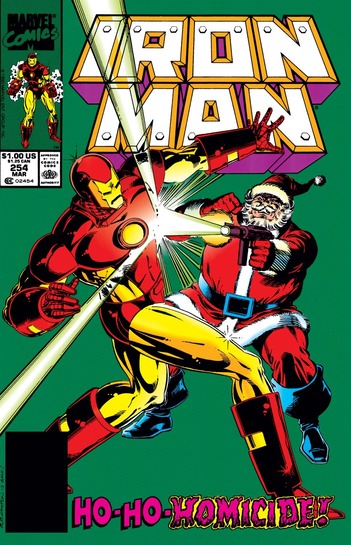 Scott Hepburn’s art and Matt Milla’s colors are phenomenal. David F. Walker’s writing is full of Christmas joy. The rapport between Cage’s daughter and her ‘uncle’ Iron Fist is adorable, especially as they bond over their love for the characters from the year’s hottest toy. Like Transformers, though, those toys are more than meets the eye. Some other special guests make appearances and add to the mix. If you’re looking to spend time with The Heroes for Hire over your holiday break, this issue is worth digging through back issues to find. Iron Man #254 (March 1990) I stumbled upon this issue in a dollar bin at my local comic book shop. I was immediately drawn in by the incredible cover. How do you not have your attention grabbed and put in a chokehold by Santa Claus blasting a laser-gun at Iron Man, with a ‘Ho-Ho-Homicide’ headline written across the bottom? I didn’t have the chance to buy it the first time I saw it but, through a Christmas miracle, it was still there when I returned for it. The story is a strangely satisfying mix of heartfelt morals and intense action. In the story, Taskmaster hosts a deadly Hunger Games-eque competition to find a new Spymaster (very violent and grim). The winner of the tournament must break into the Stark Industries’ Christmas party, through high levels of security, and steal the ornament on top of the Christmas tree in order to fully graduate (very non-violent and adorable). In the end, Tony Stark spares some destruction by letting Spymaster take the ornament, stating that even a menace like Spymaster deserves some good will at Christmastime. Iron Man #254 is the ‘is Die Hard a Christmas movie?’ of comics. Despite being released in March, the story is set around Christmas and takes place in a winter-simulating inflatable dome built across the street from Stark’s office (the dome allows for a wintery office Christmas party in an otherwise hot and sunny Southern California). It includes some great Christmas puns and Spymaster dressed as Santa, although I could’ve used more scenes of Santa fighting Iron Man as shown on the cover. Instead, early into his infiltration, Spymaster (hilariously) removes his Santa mask suit to reveal a full Spymaster suit underneath. Another very fun and very 1990 specific treat is that the issue includes a Nintendo Power Glove reference. This issue was a great blast from Christmas past and I’m glad I found it. Written by Zeke Perez Jr. 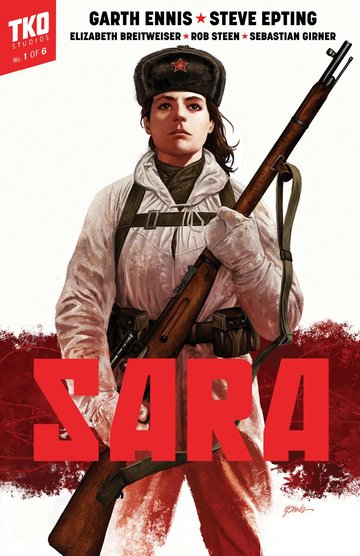 The way we watch TV shows in 2018 is a far cry from how we did in a not so distant past. Just 10 years ago, let’s say, the most typical way people followed a given program was on a week-to-week basis. The Netflix-style subscription model has reframed that. Now, instead of tuning in for appointment television weekly, people are willing to play the long game between seasons and wait for all of a show’s episodes to come out at once. A new comic publisher - TKO Studios - is asking why the same can’t be done in the world of comic books. Why should people wait month-to-month for each new issue of a comic to drop? And why should they wait for months after the final issue of a run to see the whole collection gathered in a trade paperback? TKO hopes to present a solution to those questions, aiming to give its readers quality content, all up front. On December 10th, TKO Studios posted a thread on Twitter that certainly sought to rattle the cages of the current comic book industry, claiming that it hopes to be the ‘first modern comic book company.’ In the thread, TKO laid out its star-studded staff, its new approach, and an invitation to check out its content and give it a shot. TKO Studios wants to give readers the opportunity to binge-read comics the way they sit down to binge-watch episodes of their favorite shows. They want the readers to have control over how they pace the series, rather than waiting months to see how the story unfolds. To accomplish that, TKO plans to release all six issues for each of its miniseries at one time. To accommodate a variety of readers and collectors, each miniseries will be released in three formats: as six individual issues packaged in a collector’s box, as a trade paperback, or digitally. All will be in the deluxe oversized style to best show off the art. While products are available for purchase straight from TKO, they’ve stated that they’re also up for working with comic shops to get their physical products in stores. TKO Studios isn’t just putting forward a novel idea. They’re backing that idea up with quality creators and content. The all-star staff features big players in the comic industry, such as Roxane Gay (World of Wakanda), Jeff Lemire (Essex County, Sweet Tooth), Jordie Bellaire (Batman, The Wake), and Gabriel Walta (The Vision), just to name a few. Tze Chun is on as co-founder and publisher, with Sebastian Girner serving as Editor-in-Chief. The assembled crew is diverse and acclaimed, with several Eisner-winners and nominees involved. With such an experienced and talented team, there is little doubt that the quality will be there. 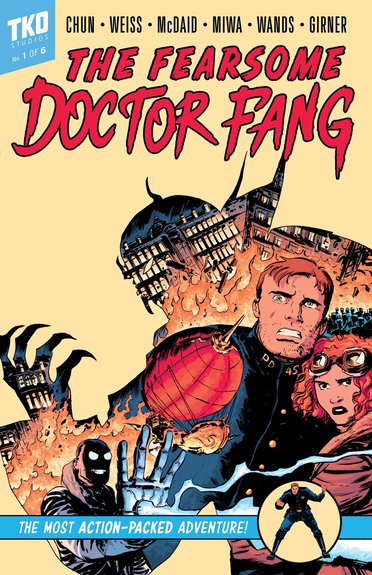 TKO has introduced four launch titles already, with four more titles on the way. Thus far, they have a war serial focused on a female sniper (Sara), a Western (The 7 Deadly Sins), a tale that harkens back to the old horror comic days (The Fearsome Doctor Fang), and a unique murder mystery (Goodnight Paradise). Each title brings about fantastic new combinations of writers and artists who may not have had the opportunity to collaborate before, setting up limitless potential. I’m somewhat torn on the idea of this new business model, but also very intrigued by it. While I do like the anticipation that builds when waiting for comics to release on the traditional timeframe, I also find myself falling behind on comics easily if I’m not able to make it to my comic shop to pick up my pull list on a given week. In practice, then, I do often tend to binge-read my comics anyway, waiting until they pile up before I dig through them. The publishing approach that TKO is putting forward seems to fit nicely with how I already read my comics, but it might be an adjustment for folks who look forward to new comic book day every Wednesday and who devour their new pickups the day of. I am also hopeful about the positive implications this approach might have for writers and artists. Sitting in on panels at various comic conventions, I’ve heard comic creators talk about the pressures of publisher deadlines. I’ve also seen comic series that were slated for a larger run get cancelled and, as a result, watched the creators struggle to wrap up their intended story in the few remaining issues they had left. I’m curious to see if releasing comics in a bundle might provide writers and artists a little more freedom, allowing them to work on their publications well in advance and to pace their stories how they desire. While TKO Studios is obviously taking some big risks with its new model, I’m given a boost of confidence based on the people who are behind the company. In other types of media that are shifting away from the status quo, it seems the most successful attempts are those that are grassroots efforts, with individuals on the inside creating change. An example that comes to mind is the sports journalism site, The Athletic. The site hoped to move away from the ad and click-driven model that the traditional sports page was turning into. The site’s creators hired great sports writers within the industry to spur the movement, banking on them to create quality content. With the knowledgeable team TKO has assembled, it is poised to challenge key players in the comic book industry. The TKO Studios site is up for preview now, using the password “vipaccess” to enter. On the site, readers will find the four aforementioned series available for purchase. Right now, the full first issue of each series is available to read for free. Readers can also pre-order the next four series that are slated to come out. I’m personally most excited about Sara and The Fearsome Dr Fang from the first set and I’m most looking forward to Sentient, The Banks, and Pound for Pound in the next batch. Time will tell if TKO Studios can go for the knockout in its battle with the comic book industry, but their early releases are promising. You can find TKO Studios on Twitter (@TKOpresents), Instagram, and Facebook. Written by John Edward Betancourt 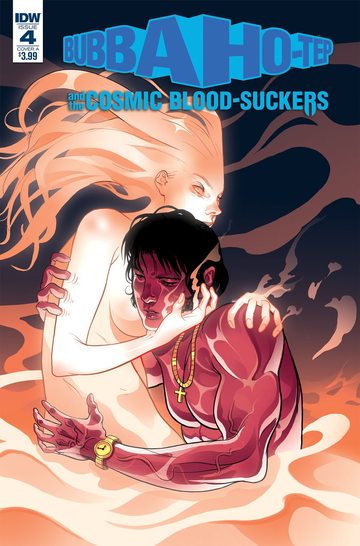 When we think of the word hero, certain images come to mind. We instantly think of comic book characters who wear capes and have super-strength, or we think of people who are one hundred percent willing to put themselves into harm’s way in order to save lives or make the world a safer place. But the fact of the matter is, sometimes heroism doesn’t come from a noble place. Sometimes people do the right thing out of fear. Because a fear for one’s own safety, and the safety of others is a powerful motivator to take action and while history will look upon the act as noble or just, those involved will always know, that their push to do something more came from a far different place. Why all of that matters for the sake of this review, is because that alternate side of heroism, just so happens to be the focus of the fourth issue of Bubba Ho-Tep and the Cosmic Blood-Suckers. Because this particular tale, picks up almost immediately after the blood-bath of a battle featured in the prior issue, one where Jack was taken by the evil to be used as bait to draw out the King and his friends and while one’s first impression of such an act would be that our heroes would immediately venture out into the world and bring Jack home with guns blazing, that simply wasn’t the case here. Instead, what we were treated to was a hyper realistic debate as the team licked their wounds and took inventory upon the situation. Which quite frankly was a genius stroke of storytelling. Because the team has now seen just how powerful and terrifying these beings really are, and any further action should give them pause since the danger is real and while the discussion as to whether or not to save Jack was fascinating in its own right, since it was in fact grounded in utter fear, what matters more here is that Elvis reached a point where he realized that inaction was a far worse way to go. It would mean horrible things for Jack and for others if they left the power of this monster unchecked and there was something supremely uplifting and powerful emanating from the page as he dug in and made the call to go after Jack and deal with this threat on its home turf. If anything, the inspiration and wonder that came from watching Elvis make the call to play the hero and take the fight to evil only grew as the issue rolled on because the monsters simply didn’t expect a good ol’ fashioned ass whipping to come to their way, and while the team was a touch too late in saving Jack since the evil did unspeakable things to the poor man, and they were forced to bestow a merciful death upon him, they made every last creature pay and pay dearly for hurting their friend and hell, they even managed to force the big squirmy thing from another world to retreat and really when all is said and done, this issue was downright brilliant. I loved how its themes were subtle yet powerful and that the action that was present in the last issue continued, and that every theme and concept this series has been working with comes together in magnificent and smooth fashion here and well, there’s a good reason as to why everything is assembled in this particular chapter because as it turns out, this served as the penultimate issue for this incredible tale. For the monster has returned home to gather reinforcements and the team is going to make sure that everything is safe at its base of operations before moving on, meaning that a powerful showdown is on its way for the finale and well, while this issue was powerful in its own right, discovering that the end of this story is near leaves me with a little sadness in my heart. Because this has simply been a magnificent ride, and this kind of quality writing is just hard to come to by, and I really cannot get over the wonder of this adaptation of Joe Lansdale’s work. But, while the end is near, I have no doubt that the finale of this epic series will exceed my expectations thanks to the care that Writer Josh Jabcuga and Artist Tadd Galusha have put into every single page of this comic and while I wait for that powerhouse finale, I can bask in the wonder of this issue, the one that brought everything together and popped off the page with magnificent artwork as I quietly prepare myself for the end of one stunning journey. Until next time. Written by Joel T. Lewis 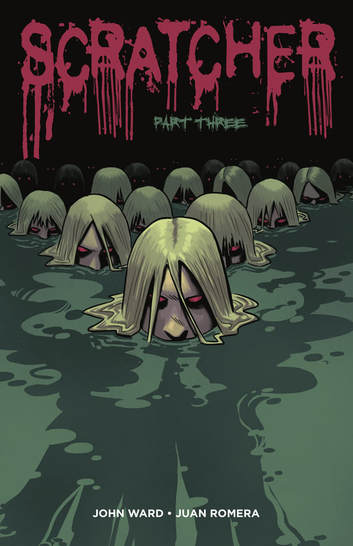 Writer John Ward and Artist Juan Romera serve up another much-needed dose of refreshing Horror with Scratcher: Part Three. This issue sees the triumphant return of Tattoo artist (Scratcher) Dee Williams in pursuit of another of her clients. This time it’s Lucy Ciba, a college sorority girl out of Austin, Texas whose tainted tattoo compels her to run amok inside her sorority house. With the unexpected help of Father Jerry Jones, Dee discovers that the inky terror she’s accidentally unleashed might not be as easily dealt with as she first thought. For a genre that is constantly re-framing and re-examining what we are afraid of in society horror is almost by definition self-referential. As you track the evolution of these stories through film, comics, and even video games you can spot homages and variations on familiar themes as creators play with audience expectations by subverting and leaning on the influences of those that came before, with the best of these escapes being termed ‘derivative’ or ‘rehash’ by using their knowledge of the genre and the audience’s familiarity with its images and themes to mislead and surprise that audience. John Ward has done just that with Part Three. Beautifully paced, weaving a meaningful subplot via flashbacks, Part Three effortlessly dances between gore and psychological terror reminding me again of Evil Dead but this time with a dash of Land of the Dead thrown in. Dee continues to be a rich and complex character whose self-examination aids and balances her narrative arc and she’s not bad with a machete either. Ward’s clever subversion of expectations with how one should handle the monstrous tattoos he’s imagined is skillfully executed and really a satisfying play on the tropes of infection and possession in horror. Romera’s artwork continues to be compelling, dynamic, and sinister, balancing the intimate accuracy of his character’s facial expressions and the eerie stillness he accomplishes in the moments before machete meets flesh. It’s not just that Romera’s faces are expressive, it’s that he captures the subtle nuances of escalating horror and dread as an insidious inky skull looms over Dee’s hospital bed and crafts a sorority house massacre as blood soaked and gory as can be hoped for. With his mastery of shadow and texture Romera is able to convey the crescendo-ed terror of a face to face confrontation, but also the voiceless horror of dramatic irony as he shows us what is silently inching toward our heroine. This is a talented duo at the helm of a horror comic that is consistently refreshing. Ward and Romera are creative talents to watch and treasure and I can’t wait for the next issue! Until Next Time, Geek On! Special thanks goes out to John Ward for providing Nerds That Geek with a review copy of Scratcher: Part 3 and you can find your copy and the rest of the Scratcher series at Comix Central. Written by Joel T. Lewis 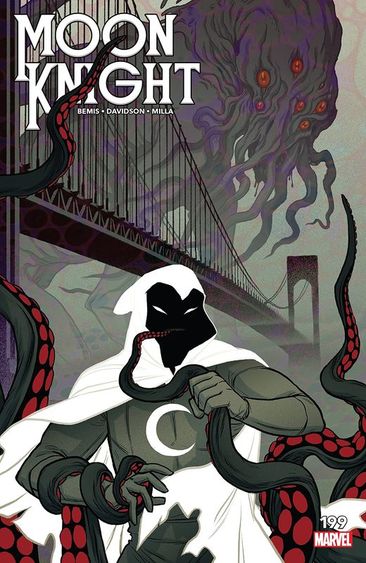 Reading issue 199 of Moon Knight was a harrowing experience. It is a tough and tedious read which sees an exhausted Marc Spector and a dapper Uncle Ernst shoved into panels overcrowded with Lovecraftian monsters and endless speech bubbles as Ernst attempts to break Marc’s mind...again. Aided by the psychedelic influence of the numerous drugs pumped into Marc’s body, Ernst seems to be trying to show Moon Knight that it’s okay to be a monster because everyone else is? I framed that sentence as a question because it's unclear what Ernst’s point or goal is in berating Marc with his stream of consciousness soliloquy, but by the end Marc breaks free from the drugs’ influence and Khonshu sets Ernst’s heart on fire. Oh and on the final page Sun King returns. I can’t sugarcoat it dear readers, issue 199 is the worst kind of faux-topical social commentary whose hackneyed use of buzzwords and phrases like ‘gentrification’ and ‘Me Too; alienate the very readers those topics are meant to galvanize. Ernst’s eye-wateringly long monologuing is blaringly unpolished, confusing, and self-indulgent and instead of leading the audience to a deeper understanding and consequent hatred for Ernst, Bemis’ writing becomes this issue’s worst villain. What I don’t understand is why the previous two issues made every effort to rush through plot points and character development just to lead up to an issue so self-indulgent and meandering. All I can say is thank Khonshu for Paul Davidson’s artwork. As difficult as this issue was to read, I honestly loved looking at the art. From the open-palmed slap Marc receives from a hipster dad walking by on the street, to the puffy ‘Dazzler’ winter coat he dons at the end of the issue, and all the hairy, slimy, winged, horned, and tentacled creatures in between Davidson delivers. In an issue where we do not see Moon Knight out in full regalia, for an artist to make every inch of every panel interesting and expressive almost eclipses the poor quality of the writing. It doesn’t make up for it, but at the very least it gives you images worth throwing down $3.99 for. I don’t know what happened with this issue readers. The stream of consciousness feel of Ernst’s speeches try to establish that the sadist society he founded has been as far reaching and influential as the Hand or Hydra but the delivery doesn’t inspire dread or awe in Marc or the reader. There was a vicious simplicity to Ernst when he was introduced as the author of all Marc’s pain, he was an elder terror who vanished mysteriously never to be seen again. But what Bemis turned him into, the leader of shadow society who caused gentrification in Brooklyn, is pretty uninspiring and dull. I am aware that Mr. Bemis experienced some pretty significant mental health issues while writing the final issues of this run of Moon Knight, and while I empathize and understand those factors, the work must stand on its own, and in this case, it sadly does not. Moon Knight 200 is a pretty significant milestone, and it marks the return of creators David Finch (on a variant cover), Jeff Lemire (on an interior page), and Moon Knight legend Bill Sienkiewicz (on an interior page). At 32 pages long the final issue of Max Bemis’ run on Moon Knight is quite literally a big one and I really hope that it concludes with the fun, wackiness, and character that I know Bemis is capable of. Until Next Time, Geek On! Written by Joel T. Lewis 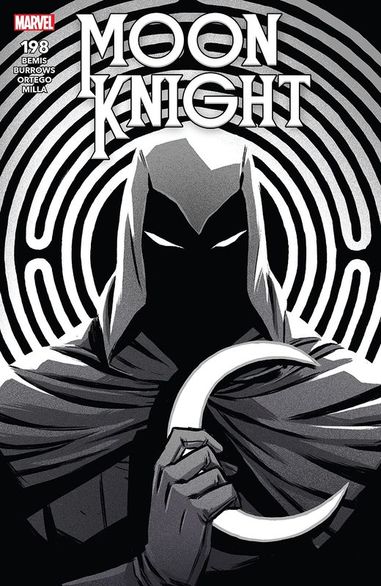 After the disappointment of the previous issue, Moon Knight 198 is not exactly a return to form but certainly a step in the right direction. In this issue I am most grateful for the newfound coordination between artist Jacen Burrows and colorist Matt Milla making this issue’s purple tinged backdrop a huge improvement over last month’s disjointed mayhem. Thankfully, issue 198 also marks the return of Bemis’ peculiar whacky tone for the jet and silver avenger as he pits Moon Knight against the Societe des Sadique’s six trials for induction. Trial one sees Moon Knight killing and eating a rabid dolphin, in the second he mutilates an unethical torture farmer, and in the third he is diagnosed as suffering from multiple incurable neuroses by Greg Salinger, also known as the Foolkiller (another character which Max Bemis wrote for Marvel in 2017). Trial number four sees the return of one of Moon Knight’s most iconic and terrifying villains, Morpheus the Dream Eater, depicted briefly in this issue casually sipping a soda as he subjects Moon Knight to five hours of unseen nightmare torture. In trial five Marc easily defeats the other four inductee hopefuls in a bloody battle royale and in the final trial Marc Spector and Jake Lockley fight over whether they should murder an innocent little girl in order to save their own child. Thankfully, Moon Knight’s decision is the one that doesn’t turn him into a child killing monster and the issue ends with a defiant lunar legionnaire ready to face down the collective might of the Society of Sadists. Unfortunately, this issue suffers as much from a sense of running out of time as the previous issue. Six trials, a very brief throwback cameo, and a clash of personality dynamics between Marc Spector and Jake Lockley are simply too many things to jam-pack into one issue. To lament the missed opportunity of having Morpheus’ lackluster return on the basis of nostalgia alone is to descend into fanboy nonsense, however the cavalier and offhanded treatment of this cameo by Bemis himself gets at something more frustrating and problematic. 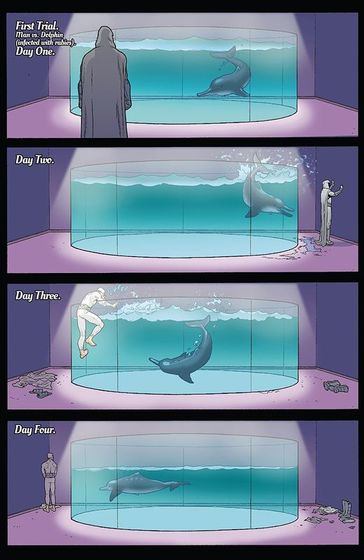 Now the rather blasé demeanor of Morpheus within this cameo as he casually sips soda and torments Marc’s psyche is tonally consistent with Bemis’ sense of humor throughout this series (I mean Marc fights and eats a rabid dolphin in the first few pages of the issue). But the Dream Eater’s halfhearted remembrance, ‘That’s for the time with thing’ demonstrates a willful omission, almost a deliberate laziness in Bemis who seems to acknowledge Moon Knight’s history with this character but not really. This cameo also suffers from its proximity to the previous arc which primarily took place within a dreamlike psyche-scape. Bemis’ decision to tell and not show us Morpheus’ subconscious torment of Marc seems to cheat us out of the visual spectacle we know this series to be capable of but this omission also seems to be the product of having only 3 issues left in the run. Had there been more time between the conclusion of the previous arc and the appearance of Morpheus, and were Bemis not exiting after issue 200, Morpheus’ return and the nightmares that he subjects Moon Knight to could have been expanded upon in all their visual splendor. But as Bemis’ is running out of time and issues before his departure, Morpheus’ inclusion in this issue seems merely tacked on and ultimately unsatisfying. Perhaps more problematic though is the unearned final confrontation between Marc and Jake over whether they are capable of murdering a little girl in order to save their daughter Diatrice. Now the legitimacy of this final exchange banks on the audience’s willingness to believe the extremes to which Jake Lockley is willing to go to protect his daughter and the bubbling over tension between his and Marc Spector’s conflicting philosophies. The problem with that is that the last true discussion of Jake’s wanton violence and Marc’s problems with his methods was 8 issues ago. The conflict between these two identities has not been gradually unfolding over that period of time which would indicate to us that Jake is capable of such cruelty or that his frustration with taking over the jobs too depraved and violent for Marc or Steven has reached the tipping point. So when Jake lashes out at Marc for his timidity and decides to murder an innocent child it seems to come out of nowhere. You don’t believe Jake capable of such horror and so his last minute ‘change of heart’ carries no weight whatsoever. Issue 198’s artwork is very much a return to form as Jacen Burrows’ Moon Knight is dynamic, brutal, and stylish as we’ve come to expect from the ‘Crazy Runs in the Family’ arc. With only two issues left before the end of his tenure on Moon Knight I’m not sure what Bemis has in store for the jet and silver avenger, but I am eager to find out. Until Next Time, Geek On! Written by Joel T. Lewis 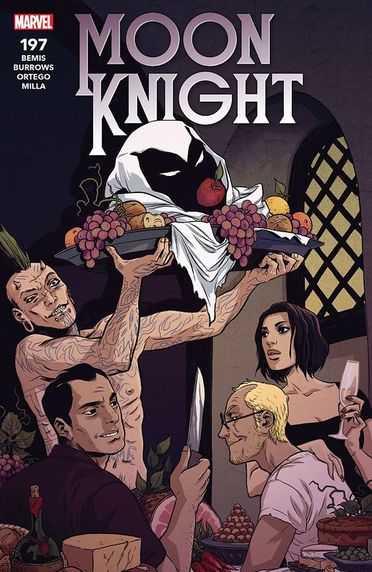 A disappointing follow-up to a particularly refreshing 2 issue arc, Moon Knight #197 feels rushed, unbalanced, and unfocused. Introducing yet another team of all new villains brought together by a common uniting philosophy, (this time they are all twisted hopefuls jockeying for induction into the macabre ‘Societe des Sadiques’) Bemis spends most of this issue rehashing and extending the formula of issue 195’s prologue. We are introduced to four Society of Sadists applicants with specialized methods of doling out pain and suffering at a candlelit dinner who lay their case for induction at the feet of a mysterious robed figure at the head of the table. In turn the snuff photographer, the mob boss assassin, the casual mass murderer serial killer, and the punk rock body piercer describe their sadistic tastes and origins. They are then joined by a fifth uninvited dinner guest. Revealing himself to be Moon Knight, Marc takes his seat at the table and makes a case of his own for induction into the society by reassuring all those in attendance that he’s going to beat the hell out of all of them and enjoy doing so immensely. Before all hell breaks loose the hooded figure and founder of the Society reveals himself to be Uncle Ernst, (the super powered Nazi whose wanton cruelty and violence caused Marc’s very first psychological break) and as the issue ends, he embraces Moon Knight, welcoming him to participate in the ritual for admission into the Society of Sadists. Unfortunately, this issue manages to feel both rushed and like filler as Ernst’s return (an event that seemed to be setup for a much later issue/arc) comes only 3 issues after his introduction in this series and the 14-page exploration of this newest motley crew drags on and on rather instead of furthering the plot. Ernst’s return and introducing another ragtag bunch of villains so soon after the Collective makes it feel as if there were supposed to be issues in between 196 and the events of this one, as if Bemis had to rush to reintroduce Ernst in time for his final issue, number 200. We don’t have time to forget Ernest and be surprised by his return which seems like a wasted opportunity. If Bemis had sent Marc on a mission to infiltrate the society of sadists and spent an issue or two with our hero following rumors and leads gleaned from broken and bloody middlemen and perhaps working his way through these new bad guys on his way to a mysterious central figure, the surprise of that last panel embrace would feel earned rather than cheap and rushed. Dropping us in at the banquet for new inductees with no build up makes us ask why do we care about this group, and why was it so easy for Moon Knight to find if Ernst has been alive, at large, and in the shadows for all of Marc’s career as Moon Knight. Not even the art could save this one for me as one of the most jarring miscalculations of this issue was the pairing of returning artist Jacen Burrows with newcomer colorist Matt Mila. After the refreshing indie-pastel combination of Paul Davidson and series regular Matt Lopes on colors in the previous 2 issues this book feels out of sync. As we explore each of the prospective society inductees’ history of cruelty the warmth of the colors used and their similarity to those used in the narrative frame of the banquet muddle the attempt at setting those flashbacks apart. And even when the color shift is dramatic, as it is in the flashbacks of the body piercer, the jolt away from the expected color scheme is more jarring than refreshing. The panels all seem to have this firelight glow that is more distracting than contributing to an underlying tone or perspective. Frankly, this issue is a mess and tonally it doesn’t even have Bemis’ unique wackiness to fall back on as a positive. It’s unclear what we can expect from the rest of this arc but I hope that my disappointment with this issue means that it can only get better. Until Next Time, Geek On! Written by John Edward Betancourt 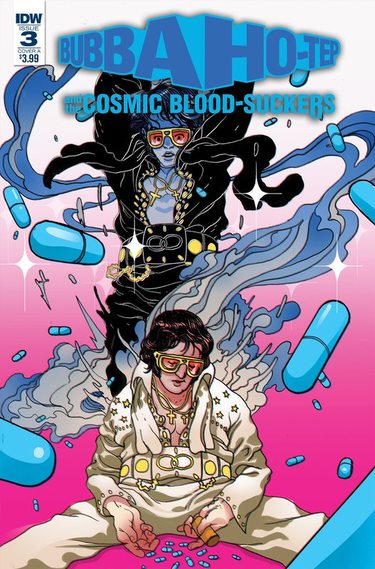 It’s rare that I take the time to re-read a comic series simply because there’s so much more on my list to dig into and for me, once I’ve gone through an issue, I feel as though I’ve absorbed what I need to absorb. But Bubba Ho-Tep and the Cosmic Blood-Suckers is a series that I continually find myself returning to simply because its magnificent story and design is incredibly unique. In fact, I’m hard pressed to think of any other comic series that is able to switch tone and design from issue to issue and still provide the reader with such a rich and amazing experience. Take the first issue for example, which more or less introduced us back into the world of Bubba Ho-Tep by providing us with a story that looked and felt like the iconic motion picture, complete with a beautiful narration that channeled the spirit of Bruce Campbell as Elvis Presley and it was nicely counterbalanced by the fascinating second issue, wherein the audience was treated to a master class on comic book writing, since this particular tale was able to provide the reader with quality and important exposition that moved at a brisk and engaging pace and well, now that I had some free time to settle in and pick up the third issue of this comic, I was quite curious as to what wonders awaited me within its pages. As it turns out, Issue #3 was going to be more of the wonderful same from this series, in that, this time around, the movie-esque feel and outright exposition present in the first two issues was replaced by something that I think we’ve all been waiting for, and something that Issue #2 implied was on its way, sweet and glorious conflict between the King’s cadre of spirit fighters and the evil now present in our world and man, this issue didn’t waste any time getting to down to business in the slightest because this one, features an epic battle so incredible, that the reader needs to take their time going through every single page of this battle royale in order to savor its wonder properly. Because the stunning artwork present here, allows for the eyes to simply feast upon the buffet of violence present in this story and I was utterly captivated by every single frame as the King and his cohorts took care of business in brilliantly gory and gooey fashion and well, it’s rare to read a comic book that actually manages to make the action on the page be as compelling as it is on the silver screen, but that’s precisely what happened here and I loved every single page of this dynamic and bold issue. I call it bold, simply because one would think it’s a touch taboo to put together an issue full of glorious violence, but hey, Writer Josh Jabcuga and Artist Tadd Galusha pulled it off without a hitch. But, there is more to be found in this issue than mystical swords and giant spirits kicking ass and taking names in the bayou. There is quite the important plot point introduced in this one in that, one of the group’s own, Jack, was kidnapped by the evil, to be used as bait to see if the monsters can draw the King and his friends into a fight on their territory and well, that sets the stage for another incredible issue. Because there’s a fair chance that the group will fail and suffer incredible losses if they go after Jack. But something tells me the King won’t leave a man behind and sadly, I’ll just have to wait until the next issue of this magnificent comic to see how this little twist wraps up. Until next time. Written by Joel T. Lewis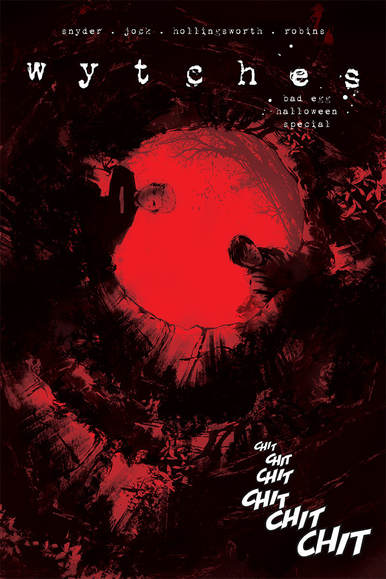 One of the signs of a great comic book collaboration is the creative team’s ability to redefine a known quantity, to come at familiar material from a new angle. Thanks to generosity of the artist Jock, I was able to read an advance copy of just that sort of collaboration: Scott Snyder and Jock’s Wytches: Bad Egg. The original Wytches series which began with Snyder and Jock’s not-so-subtle rejection of the traditional mythology of witches (the first two pages show the definition of witch as it appears in the dictionary on the first and then the same definition shredded by some unseen horror on the second) banked on their ability to reframe our understanding of a very commonplace figure of horror. The sales and wild popularity of that first 6-issue arc make a pretty good case for their having succeeded. The newly-minted creatures that Snyder termed ‘Wytches’ are far more sinister, mysterious, and interesting than the broom-striding hags whose more demonic origins (widely defined and subsequently criminalized by the publication of 1487’s Malleus Maleficarum, Latin for the ‘Hammer of Witches’) have in recent years faded into the background as witches have become more quaint figures of horror. Bad Egg is an excellent continuation by way of prequel of the mythos of these twisted horrifying creatures. It also doubles down on the domestic tension between children of a certain age and parents whose cruelty is incalculable. I like to think that effective Horror is what happens when domestic tensions are monstrously manifested in the world. The notion that the smallest of humanity’s quibbles, those small-minded moments of rage, discontent, and frustration that are uniquely human, might be taken to a very dark place and become something truly horrifying. This is executed with startling familiarity in the interactions between parents and children in Bad Egg as adolescent insecurities about how one measures up to parental expectations are stretched to twisted and monstrous proportions. Mirroring the first arc’s treatment of the classic witch myth, Jock manages to subvert the expectations of the first arc's twisted horrors cloaked in darkness by showing us those same creatures bathed in sunlight, and the effect is no less terrifying. Jock is a master of obscurity and horror through a kind of suburban strangeness and the pages that made the first arc of the series iconic, depicting chitt-chitttering blue and black heaps of tooth and claw and hunger echo and inform the art of this next chapter in new and vibrant ways. Jock’s figures’ features are starker and sharper than reality and the speckled appearance of colorful textures layered over the scenes of seemingly domestic calm build tension through the audience’s curiosity and awe. Though my reading of this installment was definitely enhanced by the recent memory of Sailor Rooks’ discovery of what the Wytches were and what they were after in the first trade, Bad Egg is a great jumping on point for the world of Wytches, as it transitions from the domestic to the supernatural smoothly and swiftly within the first few pages. It recaptures the mystique and looming fear built up by the first 6 issues and tells a uniquely tense tale in the span of 80 pages. Bad Egg is a superb continuation of the unique brand of horror created when Scott Snyder and Jock collaborate and one that you will not be disappointed in picking up when it is released on Wednesday October 31st. Until Next Time, Geek On! Special Thanks goes out to the Artist Jock who graciously provided Nerds That Geek with a Review Copy of Wytches: Bad Egg! |
Archives
May 2024
|
|
© 2012-2025, Nerds That Geek LLC.
All Rights Reserved. |
uWeb Hosting by FatCow
